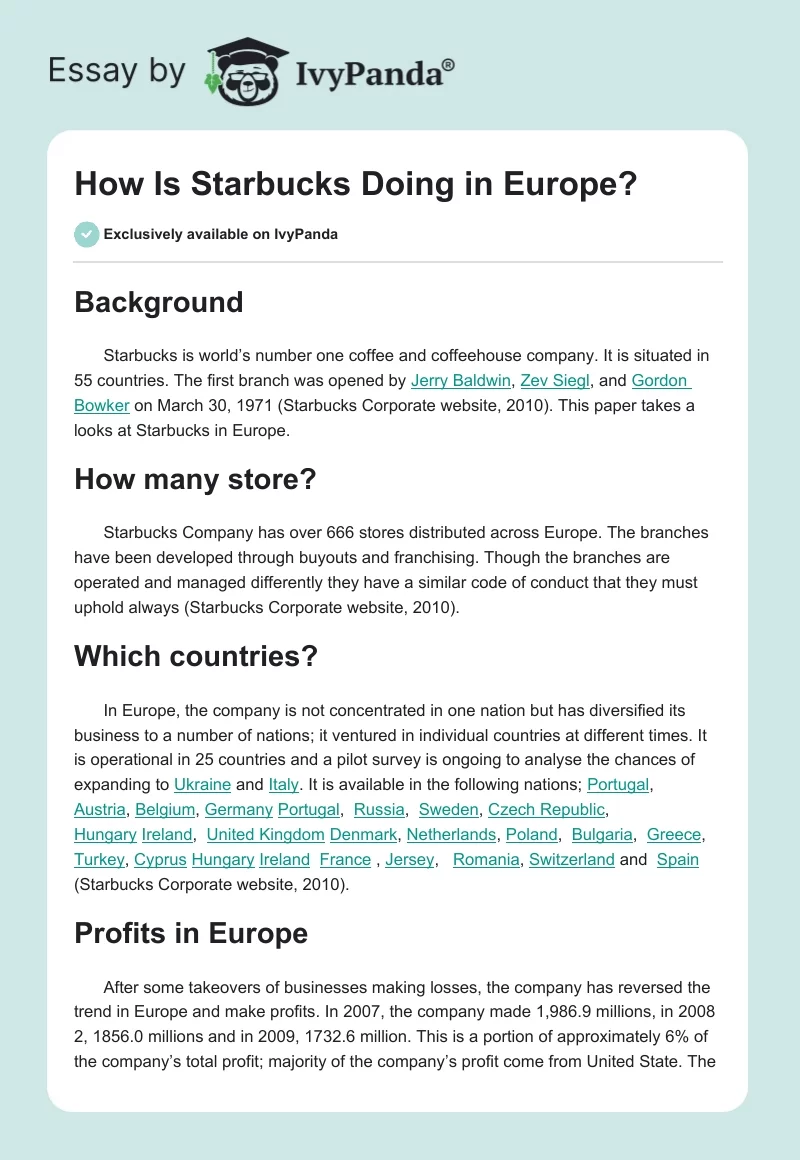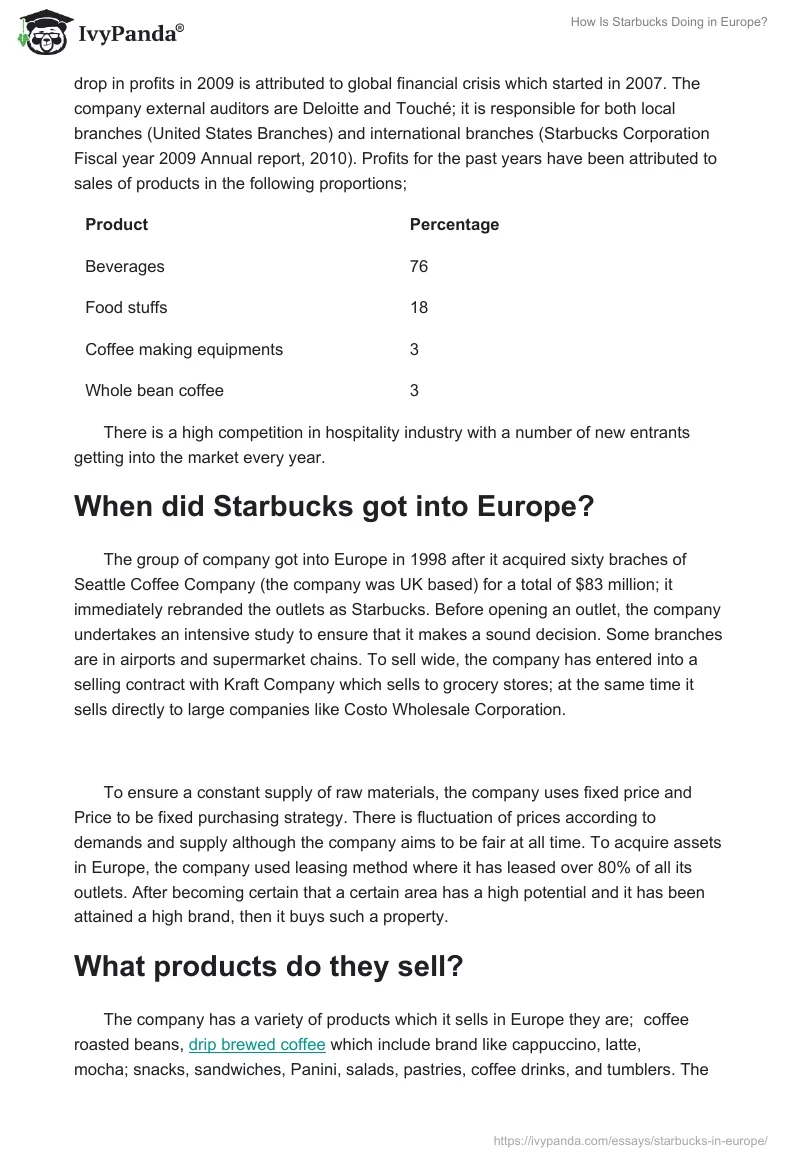Background
Starbucks is world’s number one coffee and coffeehouse company. It is situated in 55 countries. The first branch was opened by Jerry Baldwin, Zev Siegl, and Gordon Bowker on March 30, 1971 (Starbucks Corporate website, 2010). This paper takes a looks at Starbucks in Europe.
How many store?
Starbucks Company has over 666 stores distributed across Europe. The branches have been developed through buyouts and franchising. Though the branches are operated and managed differently they have a similar code of conduct that they must uphold always (Starbucks Corporate website, 2010).
Which countries?
In Europe, the company is not concentrated in one nation but has diversified its business to a number of nations; it ventured in individual countries at different times. It is operational in 25 countries and a pilot survey is ongoing to analyze the chances of expanding to Ukraine and Italy. It is available in the following nations; Portugal, Austria, Belgium, Germany, Portugal, Russia, Sweden, Czech Republic, Hungary Ireland, United Kingdom, Denmark, Netherlands, Poland, Bulgaria, Greece, Turkey, Cyprus, Hungary, Ireland, France, Jersey, Romania, Switzerland, and Spain (Starbucks Corporate website, 2010).
Profits in Europe
After some takeovers of businesses making losses, the company has reversed the trend in Europe and make profits. In 2007, the company made 1,986.9 millions, in 2008 – 2, 1856.0 millions, and in 2009 – 1732.6 million. This is a portion of approximately 6% of the company’s total profit; majority of the company’s profit come from United States.
The drop in profits in 2009 is attributed to global financial crisis which started in 2007. The company external auditors are Deloitte and Touché; it is responsible for both local branches (United States Branches) and international branches (Starbucks Corporation Fiscal year 2009 Annual report, 2010). Profits for the past years have been attributed to sales of products in the following proportions;
There is a high competition in hospitality industry with a number of new entrants getting into the market every year.
When did Starbucks got into Europe?
The group of company got into Europe in 1998 after it acquired sixty braches of Seattle Coffee Company (the company was UK based) for a total of $83 million; it immediately rebranded the outlets as Starbucks. Before opening an outlet, the company undertakes an intensive study to ensure that it makes a sound decision. Some branches are in airports and supermarket chains. To sell wide, the company has entered into a selling contract with Kraft Company which sells to grocery stores; at the same time it sells directly to large companies like Costco Wholesale Corporation.
To ensure a constant supply of raw materials, the company uses fixed price and Price to be fixed purchasing strategy. There is fluctuation of prices according to demands and supply although the company aims to be fair at all time. To acquire assets in Europe, the company used leasing method where it has leased over 80% of all its outlets. After becoming certain that a certain area has a high potential and it has been attained a high brand, then it buys such a property.
What products do they sell?
The company has a variety of products which it sells in Europe they are; coffee roasted beans, drip brewed coffee which include brand like cappuccino, latte, mocha; snacks, sandwiches, Panini, salads, pastries, coffee drinks, and tumblers. The company also is a books, films and music marketer in its stores (StarbucksCoffee.net, 2010).
What’s popular in what country?
The company’s products have different been taken differently in different Europe countries. Some countries prefer a product A than another company. The trend is as follows;
How does Starbucks pay producers in Europe?
Coffee is the main product that the company buys from farmers. It ensures that it has bought quality coffee and embraces fair trading. Fair trading is ensuring that all parties to a production benefit from the act.
This is in terms of price that the company buys raw materials and corporate social responsibilities undertaken by the company. It buys coffee directly from small scale farmers as well as large scale farmers. In 2004, the company price of coffee beans way more than double the then prevailing rate at an average $2.64 kg for coffee beans; the market rate then was1.20–$1.60.
Is it fair?
The prices that the company buys coffee beans from farmers are higher than the prevailing market rate. However it can only buy coffee which is produced in an ethical way and of high quality. In Europe the company in collaboration with Conservation international has embarked on training farmers on better ways of growing coffee.
Those who comply with the teaching sell their products to the company at a premium increasing the revenue to farmers. On the other hand the company being a leading consumer of coffee has “pulled” prices upwards.
Charities they are involved in?
As a matter of social corporate responsibilities, the company has a number of charity programs which it finances they are; Water conservation financing, this is done through Ethos® Water policy where when somebody purchases the brand then 5 cent goes to the project.
The company is engaged in youth programs aimed at training youth on entrepreneurial strategies. In 2009 a total of $2.1 million was used to finance 71 grants. The company has also entered into Bono’s (RED) For Charity where it donates money to assist those suffering from HIV.
Environmental protection
The company has a system called Shared Plane, where it aims at doing business in a way that is friendly to the environment. The system involves the producers and local community to adopt ethical production method which does not pollute the environment. The company has embarked on recycling of its waste products up to 70%.
The move is to ensure that there are minimal disposal to the environment. The company uses large amounts of water in its productions, however in a move to conserve water; it recycles over 70% of its waste water. In the effort to reduce green house emission, the company has embarked on massive energy efficient methods. This involves the use of electricity to roast coffee beans in place of charcoal (Starbucks Corporation, 2010).
References
Starbucks Corporation Fiscal year 2009 Annual report. (2010). Web.
Starbucks Corporation. (2010). “Starbucks and Fairtrade Labelling Organizations International (FLO) Announce Next Step in Commitment to Small-Scale Farmers”. Web.
Starbucks Corporate website. (2010).
StarbucksCoffee.net. (2010). Starbucks is heading to Central Europe. Web.


